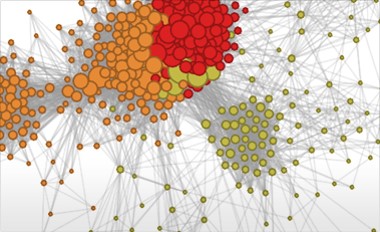People love pretty pictures. There’s no doubt some of the prettiest pictures being created these days are coming from the word of social network analytics. Better yet to know that it’s really easy to construct pictures that look like they took a long time to produce. Things like this map of email traffic flows within an organisation:
I’ve had several rather depressing conversations this week with HR-types that seem to be under the mistaken impression that this kind of picture is useful as well as pretty. The depressing bit being that they don’t seem to want to see why the picture is pointless nonsense. Maybe it’s because they’re still at the stage that the people sponsoring them to create the pictures haven’t gone past the pretty-picture wow effect themselves yet? I don’t know. I’m not sure I want to. I suspect I won’t like the answer.
I don’t think the social analytics ‘solutions’ providers want to know either. They’re too busy turning the nonsense into even more detailed micro-nonsense. Why restrict yourself to merely plotting email connections when you can also build a host of quasi-scientific sounding dashboard diagnostics.
Response Rates – how quickly do people respond to their emails?
Inside/Outside Ratios – how much correspondence occurs within the organisation relative to the outide world?
Key Players – who receives or sends the most email?
It all sounds great. Right up to the moment you start to think about it.
Should that accidently start to happen, there comes the frightening realization that none of this stuff is in any way actionable.
It’s not actionable because it’s missing a number of very important pieces of additional information. The fact that you emailed me is meaningless. The fact that you were frustrated or angry or (preferably) happy starts to give me some kind of context. What you were writing about gives me more. Was it chit-chat or did it contain some useful content? A question? An answer? Factually correct? Mis-informed? Your Mental Gear? Whether you were telling the truth? Only when I know this kind of stuff do I have the opportunity to learn anything useful.
Don’t show me a social network picture unless it shows me frustration levels. Or where the meaningful traffic is coming from and going to. These, too, might still look like pretty pictures, but now they might actually allow me to do something useful to improve the network.
Or maybe I’ve got the wrong end of the stick again? Maybe the point of the pretty pictures is to cover the cracks in the office wall? As opposed to working out why the cracks seem to be getting bigger?

